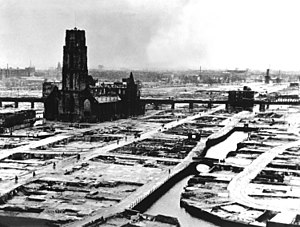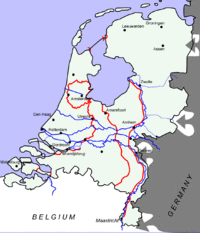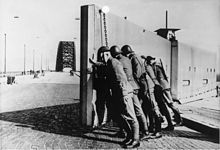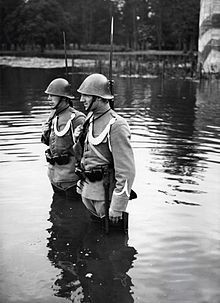Battle of the Netherlands
Battle for the Netherlands
Part of: Western Campaign

The destroyed centre of Rotterdam after the bombing in 1940
Western Campaign
Battle of the NetherlandsMaastricht
- Mill - The Hague - Rotterdam - Zeeland - Grebbeberg - Afsluitdijk - Bombardment of Rotterdam
Invasion of LuxembourgCobbler line
Battle of Belgium
Fort Eben-Emael - K-W Line - Dyle Plan - Hannut - Gembloux - Lys
Battle of FranceArdennes
- Sedan - Maginot Line - Weygand Line - Arras - Boulogne - Calais - Dunkirk (Dynamo - Wormhout) - Abbeville - Lille - Paula - Fall Red - Aisne - Alps - Cycle - Saumur - Lagarde - Aerial - Fall Brown
The Battle of the Netherlands was part of the Western Campaign during World War II. The battle began on 10 May 1940 with the invasion of army units and air landings by the German Wehrmacht. The official surrender of the Dutch government on 14 May 1940 was followed by further resistance by Dutch troops in the province of Zeeland (Fortress Holland) until 17 May.
Queen Wilhelmina of the Netherlands went into exile with her government to Britain.
The German Reich established a Reich Commissariat in the Netherlands. The Nazi state pursued its racial ideological tyranny here as well.
On 5 May 1945, Western Allied forces completed the liberation of the Netherlands. Liberation Day (Bevrijdingsdag) has since been a public holiday in the Kingdom of the Netherlands.

Phases of the German conquest of the Netherlands
Initial Situation
The United Kingdom and France had declared war on Germany in 1939 after the invasion of Poland. No major land operations took place in Western Europe during the so-called Sitzkrieg in the winter of 1939/40. On 9 October 1939, Hitler ordered plans to be drawn up for an attack on the Western Front.
The Dutch were not prepared for a German invasion. As in the First World War, the country was neutral. In view of increasing international tensions, the partial mobilization of 100,000 reservists of the armed forces took place in April 1939.
This was in recognition of the country's strategic importance. Since the Wehrmacht leadership had already been successful in Poland with the war of movement of fast armored units, it stood to reason that an attack on France would seek to circumvent the rigid defenses of the Maginot Line. The situation was similar from the point of view of the Franco-British Entente; Winston Churchill officially urged the Netherlands (as well as Belgium) to join the Alliance in a radio speech on 20 January 1940. The Dutch government had never officially determined how to proceed in the event of a German attack. The majority of ministers preferred to maintain neutrality at all costs, while a minority and Queen Wilhelmina refused at all costs to concede an advantage to the German Empire by passivity. The Dutch tried several times, unsuccessfully, to act as mediators in order to reach a negotiated peace agreement between the Entente and Germany.
After the German invasion of Norway and Denmark (Unternehmen Weserübung), the Dutch general staff realised that a conflict was inevitable. War preparations began, the Dutch border troops were put on greater alert. On April 19, a state of emergency was declared. However, large parts of the population were under the illusion that their country could be spared.
On April 10, Britain and France repeated their demand that the Dutch enter the war on their side, but this was again refused.

Securing of the Nimweg Waal bridge with the help of a barrier by Dutch soldiers during the Albanian crisis.

Dutch soldiers on guard, November 1939
Netherlands Armed Forces
In the Netherlands, all the objective conditions for a successful defence were in place: a large population density, disciplined and well-educated inhabitants, a geography that favoured the defender and a strong technological and industrial base, including its own defence industry.
The Dutch government's attitude toward the war was reflected in the state of the country's armed forces (Nederlandse krijgsmacht in Dutch), which had not significantly expanded their equipment since World War I and were inadequately armed even by 1918 standards. In the 1920s, an economic recession from 1920 to 1927 and the general easing of tensions in international relations led to a limitation of the defense budget.
Army
After September 1939 desperate efforts were made to improve the inadequate condition of the army, but with very little result. Germany, for obvious reasons, delayed her supplies; France hesitated to equip an army that would not be clearly on her side. The Soviet Union, one of the more plentiful sources of arms, was not accessible because the Dutch, unlike most other states, did not recognize the Communist regime. An attempt in 1940 to obtain Soviet equipment captured from Finland failed.
About two thousand bunkers had been built, but in rows without depth. Modern large fortifications existed only in Kornwerderzand for the protection of the Afsluitdijk.
A total of 48 infantry regiments and 22 infantry battalions were available for strategic border defense.
On 10 May the most conspicuous deficiency of the Dutch Army lay in its lack of armoured vehicles. The Netherlands was unable to procure the minimum of 146 modern tanks (110 light, 36 medium) that it had deemed necessary as early as 1937. A Renault FT tank, for which only one driver had been trained and which had the sole task of testing tank barriers, had remained the only example of its kind and was out of service by 1940. There were two squadrons of armoured vehicles, each with a dozen Landsverk-M36 or M38 vehicles. Another dozen DAF-M39 vehicles were just entering service, some still to be fitted with their main armament. A single platoon of five Carden-Loyd Mark VI tanks, used by the artillery, completed the list of Dutch tanks.
There was a particular lack in the area of artillery, which was only available at division level. The other units of the army, which had been set up as Ieichte infantry battalions and distributed throughout the country as a territorial army, had no artillery of their own. To be counted were a total of 676 howitzers and field guns: 310 Krupp 75-mm field guns, some manufactured under license; 52 105-mm Bofors howitzers, the only truly modern pieces; 144 obsolete Krupp 125-mm guns; 40 150-mm sFH13; 72 Krupp 150-mm L/24 howitzers; and 28 Vickers 152-mm L/15 howitzers. Anti-tank guns available were 386 Böhler 47-mm L/39s, which were effective weapons but were too few in number to reach only one-third of the planned strength; another three hundred antiquated 6-field (57-mm) and 8-Staal field (84-mm) guns played the same role. At the time of the invasion, only eight of the 120 modern 105-mm guns ordered from Germany had been delivered. Most of the artillery pieces were not motorized, but were horse-drawn.
The Dutch infantry used about 2,200 7.92 mm caliber machine guns, some of them manufactured under license, and eight hundred Vickers machine guns. Many of these were installed in the bunkers. Each battalion had a heavy machine gun company of twelve men. The Dutch infantry squads were equipped with a light machine gun, the M.20 Lewis machine gun, of which about 8,000 were available. Most Dutch infantrymen were equipped with the M.95 rifle, which had been introduced in 1895. There were only six 80-mm mortars for each regiment. This lack of firepower seriously affected the combat performance of the Dutch infantry.
Although the Netherlands was the headquarters of Philips, one of the largest manufacturers of radio equipment in Europe, the Dutch army mainly used telephone connections. Only the artillery was equipped with the modest number of 225 radios.
Marine
The Royal Netherlands Navy (Koninklijke Marine) had only small units in its home waters. Most of them were located in the East Indies in the Dutch Indies (today: Indonesia).
A gunboat could successfully intervene in the battle for the Afsluitdijk.
All units retreated to the United Kingdom after the German occupation.
Air Force
The Dutch Air Force, which was not yet an independent branch of the Dutch Armed Forces but part of the Army, had 155 aircraft at its disposal on 10 May: 28 Fokker G.I; 31 Fokker D.XXI and seven Fokker D.XVII; ten Fokker T.V twin-engined fighters, 15 Fokker C.X and 35 Fokker C.V light bombers, 12 Douglas DB-8 dive bombers (used as fighters), and 17 Koolhoven FK.51 reconnaissance aircraft. - thus 74 of the 155 airplanes were still biplanes. Of these aircraft, 125 were operational. The remainder of the Luftwaffe school used three Fokker D.XXI, six Fokker D.XVII, a single Fokker G.I and Fokker T.V each, and seven Fokker C.V and several training aircraft. A further forty operational aircraft, together with about the same number of reserve and training aircraft, served the naval air service (Marineluchtvaartdienst).
Status of operational readiness
The Dutch army was not only poorly equipped, but also poorly trained. Especially in the command of larger units above battalion level there was a lack of experience. From 1932 to 1936, the Dutch Army did not conduct field maneuvers in the summer for reasons of economy. In addition, the individual soldier lacked many necessary skills. Before the war, only a minority of conscript young men had actually been drafted. By 1938, recruits served for only 24 weeks, just enough to receive basic infantry training. That same year, service was extended to eleven months. The low quality of conscripts was not compensated for by professional soldiers. In 1940 there were only 1,206 professional officers. It had been hoped that these deficiencies could be quickly remedied when war threatened, but after the mobilization of all Dutch forces on 28 August 1939 (which increased the armed forces to about 280,000 men), the state of training improved only slowly: most of the available time was spent on building defenses. During this period, shortages of practice ammunition, among other things, limited training. Unit cohesion remained low. Basically, the Dutch Army was combat ineffective in May 1940. It was incapable of conducting an offensive even at division level, while conducting large-scale operations was far beyond its capacity.

Mobile Dutch anti-aircraft gun

Dutch main lines of defence
Questions and Answers
Q: What was the Battle of the Netherlands?
A: The Battle of the Netherlands was part of the German invasion of France and the Low Countries (Belgium, Luxembourg, and the Netherlands) during World War II.
Q: When did it take place?
A: The battle lasted from 10 May 1940 until 14 May when main Dutch forces surrendered. Dutch troops in the province of Zealand continued to fight until 17 May when Germany occupied the whole nation.
Q: How did Germany use paratroopers?
A: The German Luftwaffe used paratroopers to capture several major airfields in the Netherlands.
Q: What happened after Rotterdam was bombed by Germany?
A: After Rotterdam was bombed by Germany, they threatened to bomb other large Dutch cities if Dutch forces refused to surrender. As a result, the Dutch surrendered to prevent other cities from being destroyed.
Q: How long did Germany occupy Holland for?
A: Germany occupied Holland from 1940 until 1945 when their territory was freed.
Q: Who were involved in this battle?
A: This battle involved German forces invading France and Low Countries such as Belgium, Luxembourg and Holland.
Search within the encyclopedia